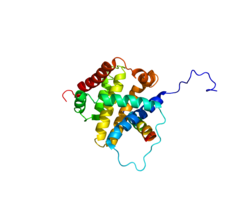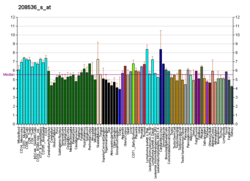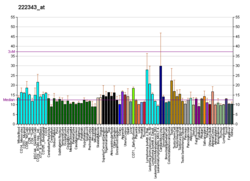
Summary
Bcl-2-like protein 11, commonly called BIM (Bcl-2 Interacting Mediator of cell death), is a protein that in humans is encoded by the BCL2L11 gene.[5][6]
| BCL2L11 | |||||||||||||||||||||||||||||||||||||||||||||||||||
|---|---|---|---|---|---|---|---|---|---|---|---|---|---|---|---|---|---|---|---|---|---|---|---|---|---|---|---|---|---|---|---|---|---|---|---|---|---|---|---|---|---|---|---|---|---|---|---|---|---|---|---|
 | |||||||||||||||||||||||||||||||||||||||||||||||||||
| |||||||||||||||||||||||||||||||||||||||||||||||||||
| Identifiers | |||||||||||||||||||||||||||||||||||||||||||||||||||
| Aliases | BCL2L11, BAM, BIM, BOD, BCL2 like 11 | ||||||||||||||||||||||||||||||||||||||||||||||||||
| External IDs | OMIM: 603827 MGI: 1197519 HomoloGene: 7643 GeneCards: BCL2L11 | ||||||||||||||||||||||||||||||||||||||||||||||||||
| |||||||||||||||||||||||||||||||||||||||||||||||||||
| |||||||||||||||||||||||||||||||||||||||||||||||||||
| |||||||||||||||||||||||||||||||||||||||||||||||||||
| |||||||||||||||||||||||||||||||||||||||||||||||||||
| |||||||||||||||||||||||||||||||||||||||||||||||||||
| Wikidata | |||||||||||||||||||||||||||||||||||||||||||||||||||
| |||||||||||||||||||||||||||||||||||||||||||||||||||
Function edit
The protein encoded by this gene belongs to the BCL-2 protein family. BCL-2 family members form hetero- or homodimers and act as anti- or pro-apoptotic regulators that are involved in a wide variety of cellular activities. The protein encoded by this gene contains a Bcl-2 homology domain 3 (BH3). It has been shown to interact with other members of the BCL-2 protein family, including BCL2, BCL2L1/BCL-X(L), and MCL1, and to act as an apoptotic activator. The expression of this gene can be induced by nerve growth factor (NGF), as well as by the forkhead transcription factor FKHR-L1 (FoxO3a), which suggests a role of this gene in neuronal and lymphocyte apoptosis. Transgenic studies of the mouse counterpart suggested that this gene functions as an essential initiator of apoptosis in thymocyte-negative selection. Several alternatively spliced transcript variants of this gene have been identified.[7]
Regulation of Bim edit
Bim expression and activity are regulated at the transcriptional, translational and post-translational levels; coordinated expression and activity of Bim shape immune responses, and ensure tissue integrity. Cancer cells develop mechanisms that suppress Bim expression, which allows for tumor progression and metastasis.[8]
Interactions edit
BCL2L11 has been shown to interact with:
See also edit
References edit
- ^ a b c GRCh38: Ensembl release 89: ENSG00000153094 – Ensembl, May 2017
- ^ a b c GRCm38: Ensembl release 89: ENSMUSG00000027381 – Ensembl, May 2017
- ^ "Human PubMed Reference:". National Center for Biotechnology Information, U.S. National Library of Medicine.
- ^ "Mouse PubMed Reference:". National Center for Biotechnology Information, U.S. National Library of Medicine.
- ^ a b c d e Hsu SY, Lin P, Hsueh AJ (November 1998). "BOD (Bcl-2-related ovarian death gene) is an ovarian BH3 domain-containing proapoptotic Bcl-2 protein capable of dimerization with diverse antiapoptotic Bcl-2 members". Mol Endocrinol. 12 (9): 1432–40. doi:10.1210/mend.12.9.0166. PMID 9731710.
- ^ a b c d O'Connor L, Strasser A, O'Reilly LA, Hausmann G, Adams JM, Cory S, Huang DC (February 1998). "Bim: a novel member of the Bcl-2 family that promotes apoptosis". EMBO J. 17 (2): 384–95. doi:10.1093/emboj/17.2.384. PMC 1170389. PMID 9430630.
- ^ "Entrez Gene: BCL2L11 BCL2-like 11 (apoptosis facilitator)".
- ^ Sionov RV, Vlahopoulos SA, Granot Z (2015). "Regulation of Bim in Health and Disease". Oncotarget. 6 (27): 23058–134. doi:10.18632/oncotarget.5492. PMC 4695108. PMID 26405162.
- ^ a b c Chen L, Willis SN, Wei A, Smith BJ, Fletcher JI, Hinds MG, Colman PM, Day CL, Adams JM, Huang DC (February 2005). "Differential targeting of prosurvival Bcl-2 proteins by their BH3-only ligands allows complementary apoptotic function". Mol. Cell. 17 (3): 393–403. doi:10.1016/j.molcel.2004.12.030. PMID 15694340.
- ^ Whitfield J, Harada K, Bardelle C, Staddon JM (November 2003). "High-throughput methods to detect dimerization of Bcl-2 family proteins". Anal. Biochem. 322 (2): 170–8. doi:10.1016/j.ab.2003.07.014. PMID 14596824.
- ^ Day CL, Puthalakath H, Skea G, Strasser A, Barsukov I, Lian LY, Huang DC, Hinds MG (February 2004). "Localization of dynein light chains 1 and 2 and their pro-apoptotic ligands". Biochem. J. 377 (Pt 3): 597–605. doi:10.1042/BJ20031251. PMC 1223895. PMID 14561217.
- ^ Vadlamudi RK, Bagheri-Yarmand R, Yang Z, Balasenthil S, Nguyen D, Sahin AA, den Hollander P, Kumar R (June 2004). "Dynein light chain 1, a p21-activated kinase 1-interacting substrate, promotes cancerous phenotypes". Cancer Cell. 5 (6): 575–85. doi:10.1016/j.ccr.2004.05.022. PMID 15193260.
- ^ Bae J, Leo CP, Hsu SY, Hsueh AJ (August 2000). "MCL-1S, a splicing variant of the antiapoptotic BCL-2 family member MCL-1, encodes a proapoptotic protein possessing only the BH3 domain". J. Biol. Chem. 275 (33): 25255–61. doi:10.1074/jbc.M909826199. PMID 10837489.
- ^ Heckmeier PJ, Ruf J, Buhrke D, Janković BG, Hamm P (September 2022). "Signal Propagation Within the MCL-1/BIM Protein Complex". Journal of Molecular Biology. 434 (17): 167499. doi:10.1016/j.jmb.2022.167499. PMID 35189130.
Further reading edit
- Wang K, Yin XM, Chao DT, et al. (1996). "BID: a novel BH3 domain-only death agonist". Genes Dev. 10 (22): 2859–69. doi:10.1101/gad.10.22.2859. PMID 8918887.
- Zha J, Harada H, Yang E, et al. (1997). "Serine phosphorylation of death agonist BAD in response to survival factor results in binding to 14-3-3 not BCL-X(L)". Cell. 87 (4): 619–28. doi:10.1016/S0092-8674(00)81382-3. PMID 8929531. S2CID 860908.
- Huang DC, Adams JM, Cory S (1998). "The conserved N-terminal BH4 domain of Bcl-2 homologues is essential for inhibition of apoptosis and interaction with CED-4". EMBO J. 17 (4): 1029–39. doi:10.1093/emboj/17.4.1029. PMC 1170452. PMID 9463381.
- Puthalakath H, Huang DC, O'Reilly LA, et al. (1999). "The proapoptotic activity of the Bcl-2 family member Bim is regulated by interaction with the dynein motor complex". Mol. Cell. 3 (3): 287–96. doi:10.1016/S1097-2765(00)80456-6. PMID 10198631.
- Ohi N, Tokunaga A, Tsunoda H, et al. (1999). "A novel adenovirus E1B19K-binding protein B5 inhibits apoptosis induced by Nip3 by forming a heterodimer through the C-terminal hydrophobic region". Cell Death Differ. 6 (4): 314–25. doi:10.1038/sj.cdd.4400493. PMID 10381623.
- Bouillet P, Metcalf D, Huang DC, et al. (1999). "Proapoptotic Bcl-2 relative Bim required for certain apoptotic responses, leukocyte homeostasis, and to preclude autoimmunity". Science. 286 (5445): 1735–8. doi:10.1126/science.286.5445.1735. PMID 10576740.
- Dijkers PF, Medema RH, Lammers JW, et al. (2000). "Expression of the pro-apoptotic Bcl-2 family member Bim is regulated by the forkhead transcription factor FKHR-L1". Curr. Biol. 10 (19): 1201–4. Bibcode:2000CBio...10.1201D. doi:10.1016/S0960-9822(00)00728-4. PMID 11050388. S2CID 17945478.
- Bouillet P, Zhang LC, Huang DC, et al. (2001). "Gene structure alternative splicing, and chromosomal localization of pro-apoptotic Bcl-2 relative Bim". Mamm. Genome. 12 (2): 163–8. doi:10.1007/s003350010242. PMID 11210187. S2CID 7225766.
- Putcha GV, Moulder KL, Golden JP, et al. (2001). "Induction of BIM, a proapoptotic BH3-only BCL-2 family member, is critical for neuronal apoptosis". Neuron. 29 (3): 615–28. doi:10.1016/S0896-6273(01)00238-0. PMID 11301022. S2CID 16223140.
- Murray S, Halford S, Ebenezer ND, et al. (2001). "Assignment of BCL2L11 to human chromosome band 2p13 with somatic cell and radiation hybrids". Cytogenet. Cell Genet. 92 (3–4): 353. doi:10.1159/000056930. PMID 11435715. S2CID 32790948.
- Cheng EH, Wei MC, Weiler S, et al. (2001). "BCL-2, BCL-X(L) sequester BH3 domain-only molecules preventing BAX- and BAK-mediated mitochondrial apoptosis". Mol. Cell. 8 (3): 705–11. doi:10.1016/S1097-2765(01)00320-3. PMID 11583631.
- Mami U, Miyashita T, Shikama Y, et al. (2002). "Molecular cloning and characterization of six novel isoforms of human Bim, a member of the proapoptotic Bcl-2 family". FEBS Lett. 509 (1): 135–41. doi:10.1016/S0014-5793(01)03145-3. PMID 11734221. S2CID 82875886.
- Bouillet P, Purton JF, Godfrey DI, et al. (2002). "BH3-only Bcl-2 family member Bim is required for apoptosis of autoreactive thymocytes". Nature. 415 (6874): 922–6. doi:10.1038/415922a. PMID 11859372. S2CID 1404636.
- Marani M, Tenev T, Hancock D, et al. (2002). "Identification of novel isoforms of the BH3 domain protein Bim which directly activate Bax to trigger apoptosis". Mol. Cell. Biol. 22 (11): 3577–89. doi:10.1128/MCB.22.11.3577-3589.2002. PMC 133811. PMID 11997495.
- Liu JW, Chandra D, Tang SH, et al. (2002). "Identification and characterization of Bimgamma, a novel proapoptotic BH3-only splice variant of Bim". Cancer Res. 62 (10): 2976–81. PMID 12019181.
- Terradillos O, Montessuit S, Huang DC, Martinou JC (2002). "Direct addition of BimL to mitochondria does not lead to cytochrome c release". FEBS Lett. 522 (1–3): 29–34. doi:10.1016/S0014-5793(02)02871-5. PMID 12095614. S2CID 20419085.
- Sugiyama T, Shimizu S, Matsuoka Y, et al. (2002). "Activation of mitochondrial voltage-dependent anion channel by apro-apoptotic BH3-only protein Bim". Oncogene. 21 (32): 4944–56. doi:10.1038/sj.onc.1205621. PMID 12118373.
External links edit
- BCL2L11 human gene location in the UCSC Genome Browser.
- BCL2L11 human gene details in the UCSC Genome Browser.








